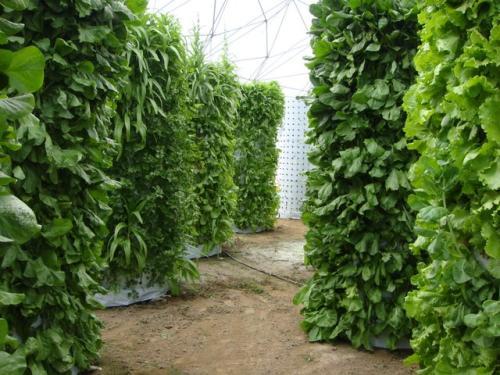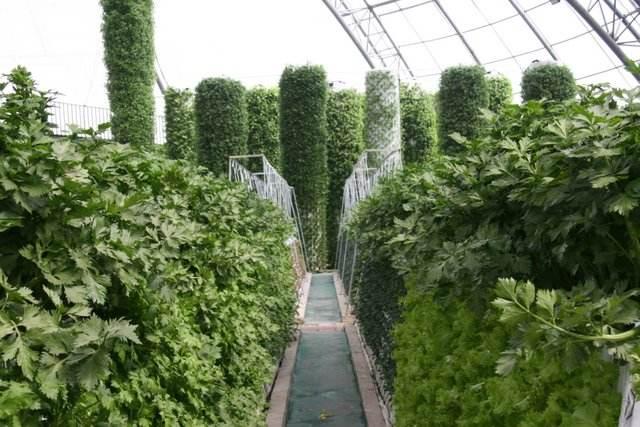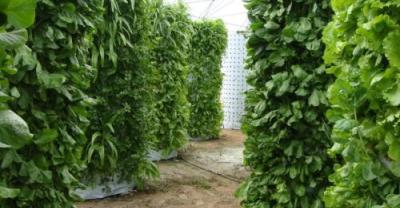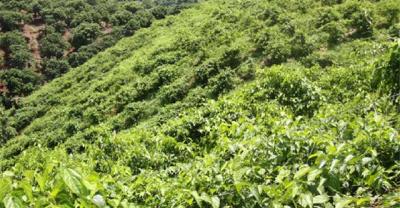Aerosol planting Technology of Industrial vegetables in Jiangmen City
Aerosol planting Technology of Industrial vegetables in Jiangmen City
Aerosol cultivation technology is a new vegetable soilless cultivation technology in recent years, which is only planted on a small scale in the form of pilot in our country, which is lack of experience and difficult to popularize. In order to explore the advantages and disadvantages of aerosol cultivation technology, summarize practical experience and provide reference information to agricultural science and technology enterprises and farmers, Jiangmen Agricultural Science and Technology Innovation Center established about 1000 m2 tower aerosol cultivation equipment and experimented for one year.

1 application of aerosol cultivation technique
In the construction of the facility, a high-strength foam planting plate is obliquely laid on the planting rack with a triangular longitudinal section, so that a closed space called aerosol chamber is formed in the middle of the planting rack, in which aerosol sprinklers are installed. The seedlings of plant height 8cm were fixed on the holes of the foam planting plate with sponges, so that the roots of vegetables were exposed in the aerosol chamber. Spray nutrient solution regularly in the aerosol chamber to make vegetables get enough water, oxygen and nutrient elements.
1.1 Aerosol cultivation is a resource-saving planting method
Compared with the traditional hydroponic culture, aerosol cultivation sprays the foggy nutrient solution directly on the root of vegetables, which requires less nutrient solution, saves about 60% of the water and fertilizer, and improves the utilization rate and accuracy of the nutrient solution. The unused atomized nutrient solution will be collected and sterilized by ultraviolet light and then reused until its conductivity is lower than the hydroponic index value. According to practical experience, it is usually not necessary to change the nutrient solution during the 1-2-month planting cycle of leafy vegetables. In addition, the aerosol cultivation technology adopts intermittent aerosol spraying, which does not need continuous operation and low power consumption.
1.2 the growth rate of vegetables under aerosol cultivation is faster than that of traditional hydroponics and soil culture.
Aerosol cultivation is characterized by exposing the roots to the air and obtaining enough oxygen for respiration, so as to optimize the root environment and improve the root growth rate and absorption rate. In practice, it is found that the root system of leafy vegetables is well developed. For example, the root length of lettuce is up to 1m, which is 2-3 times that of traditional hydroponic culture. The well-developed root system increased the absorption area of vegetables to nutrient solution, and greatly increased the growth rate of vegetables under the strong absorption of root system. Compared with the traditional floating hydroponics, the growth cycle of leafy vegetables was shortened by 1 / 5.

(2) Aerosol cultivation is an example of three-dimensional planting with high space utilization.
Tower aerosol cultivation is by planting vegetables on inclined enhanced foam plates, which is conducive to making full use of the space in the intelligent greenhouse and increasing yield. In addition, the intensive production of aerosol cultivation under artificial conditions can control the planting environment, and there is no need for soil and substrate cultivation, which is of great significance to the vegetable supply in areas with bad environment and even ocean-going ships.
2.1 shortcomings of aerosol cultivation and its improvement
The management of aerosol cultivation is fine and the maintenance cost is high. Because the nutrient solution is atomized by the aerosol nozzle, and the spray hole is very fine, the nutrient solution needs to be filtered before spraying to prevent the nozzle from clogging. It is suggested that the filter condition is 400 mesh.
2.2 the sanitary conditions required for aerosol cultivation are strict.
Because the aerosol chamber is a closed space, dark and damp, if not managed properly, it will breed bacteria and fungi and affect the normal growth of vegetables. Therefore, two points should be paid attention to in management. (1) an ultraviolet lamp sterilizer should be installed to ensure that all nutrient solutions are sterilized before entering the aerosol chamber to prevent the spread of diseases. (2) after the harvest of each production cycle, the planting board can be opened, the planting board and the aerosol chamber can be dried for 3 days, which can not only be sterilized by sunlight, but also dry the planting board, thus destroying the conditions for bacterial growth.

2.3 different vegetables have different adaptability to aerosol cultivation.
In terms of planting, damage may occur during planting because the seedlings need to be wrapped in sponges and then fixed in the holes in the foam board. It is suggested that different vegetables should be planted at different stages to ensure that their stems grow to enough hardness and toughness. In general, when the plant height of vegetables is 8cm, it is suitable to be planted. In addition, aerosol cultivation causes vegetables to be planted at a three-dimensional tilt, so vegetables need to adapt to this planting angle. In practice, it is found that hollow cabbage and Guangdong cabbage are not adaptable to inclined three-dimensional planting. In terms of planting, the adaptability of vegetables to hydroponics is also different. For example, the growth of traditional hydroponic vegetable varieties of pakchoi, mustard and lettuce is the best, and the growth period is relatively traditional, and hydroponic culture is shorter, so in actual production, we should try to grow all kinds of vegetables, and then select the vegetables with the best adaptability for aerosol culture. to give full play to its advantages.
- Prev

The rich planted ginseng, but was nearly killed by others.
During the Qing Dynasty, at the junction of Xizang and Yunnan, there was a famous farmer named Qi Niu. His family grew ginseng for generations.
- Next

We should pay attention to these points when growing Chinese cabbage in summer.
The country still enters the summer, especially after the ambush, the weather is hot and hot. For some unseasonal vegetables, growth is a problem.
Related
- Fuxing push coffee new agricultural production and marketing class: lack of small-scale processing plants
- Jujube rice field leisure farm deep ploughing Yilan for five years to create a space for organic food and play
- Nongyu Farm-A trial of organic papaya for brave women with advanced technology
- Four points for attention in the prevention and control of diseases and insect pests of edible fungi
- How to add nutrient solution to Edible Fungi
- Is there any good way to control edible fungus mites?
- Open Inoculation Technology of Edible Fungi
- Is there any clever way to use fertilizer for edible fungus in winter?
- What agents are used to kill the pathogens of edible fungi in the mushroom shed?
- Rapid drying of Edible Fungi

